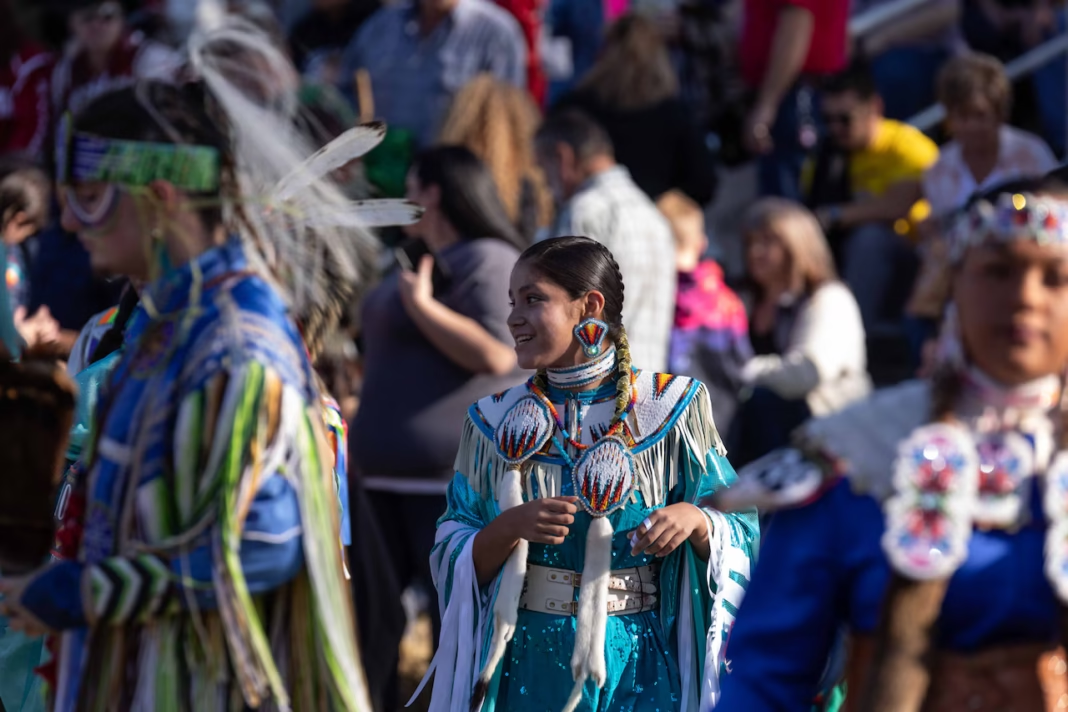The Creek Indian tribe was once home to more than twenty thousand people who lived in at least fifty towns throughout the Southeastern Woodlands. Their society followed a complex clan system that went beyond individual towns and families. This sophisticated social structure became the foundation of their cultural identity. The Creek people faced their most challenging times during the 1800s. The government forced most Creeks and their slaves to relocate to Indian Territory (now Oklahoma) in the late 1830s.
The Creek civilization had built between fifty to eighty towns and villages before this dark period. Each community had its own unique way of governing through the “idalwa” or town system [-4]. Creek tribe’s history shows how they adapted to their Southeastern woodland environment over hundreds of years. Their distinct traditions evolved naturally in this setting. European settlers changed everything. Disease and conflict reduced their population to just 10,000 by 1715. The Creeks lost their lands east of the Ocmulgee River through several treaties. These included the Treaty of New York (1790), Fort Wilkinson (1802), and Washington (1805). The Trail of Tears saw 14,609 Creeks make the brutal journey to Oklahoma. More than 15,000 natives died on different removal routes during this period.
The Origins of the Creek People
Image Source: Reddit
The Origins of the Creek People
Early migration and Mississippian roots
The Creek people’s ancestors came from the Mississippian culture that thrived in the southeastern United States from 800 to 1600 CE. These advanced societies built complex cities with earthwork mounds. Networks of smaller towns and farms surrounded these impressive centers. They were skilled farmers who grew corn, beans, squash, and sunflowers using basic tools like stone axes and digging sticks. Their society had clear differences between elite members and common people. Chiefs performed rituals from the tops of mounds and built temples to honor their ancestors on these structures.
These large chiefdoms started breaking apart during the 15th century. Spanish conquistadors likely triggered this decline by bringing disease and disruption. The people split into smaller groups that spread out to form tribal communities. These new settlements appeared across today’s Alabama, Georgia, Florida, and South Carolina.
Formation of the Creek Confederacy
The Creek Confederacy wasn’t just one tribe – it was a sophisticated alliance of independent communities. Creek oral tradition tells us their ancestors started a colony at Ocmulgee (near today’s Macon, Georgia) around 900-1000 CE. This settlement gave birth to two key towns: Cusseta and Coweta.
The confederacy grew to include many tribal towns by the early 18th century. Each town shared cultural traits but kept its political independence. British settlers called these Muscogee people “Creek.” The alliance grew through population expansion, conquest of other tribes, and taking in refugees from tribes displaced by European settlers. The Creek Confederacy became home to many groups: Yuchi, Koasati, Alabama, Coosa, Tuskegee, Coweta, Cusseta, Chiaha, Hitchiti, Tuckabatchee, and others.
Language groups and regional divisions
Creek Indians spoke several related Muskogean languages throughout their lands. People used Muskogee from the Chattahoochee to the Alabama River. Koasati and Alibamu speakers lived in the upper Alabama River basin and along parts of the Tennessee River. Hitchiti speakers settled in towns along the Chattahoochee River and across much of today’s Georgia.
British colonists saw two main groups of Creek people based on where they lived. Upper Creeks made their homes along the Coosa and Tallapoosa rivers in what’s now Alabama. Lower Creeks lived near the Chattahoochee and Flint rivers. This difference shaped their future significantly. Lower Creek tribes lived closer to English settlements and adopted more European customs and tools. Upper Creeks managed to keep more of their traditional ways because they lived farther away.
Creek Indian Tribe Culture and Society
Image Source: Dori DeCamillis
“We had no locks nor keys and therefore among us there were no thieves. When someone was so poor that he couldn’t afford a horse, a tent or a blanket, he would, in that case, receive it all as a gift.” — John (Fire) Lame Deer, Sioux Lakota holy man and author
Creek Indian Tribe Culture and Society
The Creek Indians built their society around complex relationships that shaped how they lived. Their system balanced personal freedom with group duties, which helped their community thrive for centuries.
Clan system and matrilineal lineage
The clan system was the foundation of Creek society and reached beyond individual towns and families. People from the same clan saw each other as close relatives, even if they had never met. The Wind Clan enjoyed special privileges as an elite group with members spread across every town in the confederacy. Clan membership passed down through the mother’s line, and children belonged to their mother’s clan. Men moved to their wife’s home after marriage and became part of her family. This system gave Creek women substantial power – they controlled household resources and could welcome outsiders into their community.
Red and white town divisions
The Creek people divided their towns into White (Peace) or Red (War) categories. White towns held peace councils, welcomed conquered tribes, and made laws for internal matters. Red towns took charge of declaring war, planning military campaigns, and handling diplomatic relations. This setup created balance in how they governed themselves while recognizing the need for both peace and war. Members of White clans had to join in warfare too, as their civil rank often depended on their military success.
Role of the micco and town councils
Each Creek town had a micco (village chief) as its leader. These chiefs led through persuasion rather than force and retained control only while others agreed with their decisions. Micalgi (lesser chiefs) and respected village elders called heniha helped them. The town council picked the micco for life and included representatives from each clan. The village’s power structure made sure each resident clan had leadership positions, which limited the micco’s authority.
Creek Indian tribe traditions and festivals
The Green Corn Ceremony (Busk) was the Creek culture’s most important ritual. This yearly renewal ceremony happened when early corn ripened in mid-summer and lasted four to eight days. People fasted, cleaned their bodies and homes, drank sacred medicines, and performed ritual dances during this time. The ceremony’s highlight was lighting the sacred fire, which meant a fresh start. The busk let people forgive all wrongs except murder.
Subsistence farming and communal life
The Creek people lived mainly off farming, hunting, and fishing. Women ran most farming activities while men hunted and protected the community. Each family worked a small private garden near their home and helped with the larger communal field. Towns farmed these fields together, working from one end to the other. They carefully managed their hunting grounds to protect animal populations. This balanced approach to resources kept food available year-round and promoted community teamwork.
Encounters with Europeans and the Road to Removal
“When a white army battles Indians and wins, it is called a great victory, but if they lose, it is called a massacre.” — Chiksika, Shawnee leader, influential Native American figure
Encounters with Europeans and the Road to Removal
The Creek Indian tribe first met Europeans in 1540 during Hernando De Soto’s expedition. These early meetings barely affected their way of life. The Creek people’s clothing style evolved to combine their traditional elements with European influences. They started making their traditional garments from traded woolen materials.
Trade relationships and cultural exchange
The deerskin trade became the life-blood of Creek-European relations by the early 1700s. Tens of thousands of deerskins left Charleston each year during the 1730s. English factories turned these skins into various products. Creek towns used their trading profits to buy cloth, kettles, guns, and rum. These items soon became necessary for their daily lives. European traders made their homes in Creek communities. They married Creek women and had children. Some of these children, like Alexander McGillivray and William McIntosh, later became powerful leaders.
Disease and population changes
The arrival of Europeans brought devastating results. Diseases like smallpox ravaged Creek populations. Death rates soared to more than 90%. The survivors regrouped as people moved and towns merged. The American South had about two million Native Americans before European contact. This number dropped drastically. Only about 20,000 Muscogee Indians remained by 1670.
The Red Stick War and Treaty of Fort Jackson
The Creek War of 1813-1814 started as an internal tribal conflict. Red Stick warriors attacked Fort Mims and killed about 250 defenders. American forces under Andrew Jackson fought back. Jackson’s troops defeated the Red Sticks at Horseshoe Bend on March 27, 1814. The Red Sticks lost 75% of their fighters. Jackson then forced the harsh Treaty of Fort Jackson on the Creeks. They had to give up nearly 22 million acres of land – about half of today’s Alabama and one-fifth of Georgia.
Trail of Tears and forced relocation
American authorities forced more than 23,000 Creeks to move to Indian Territory between 1827 and 1837. The 750-mile trek took about three months to complete. People walked in thin clothing through harsh weather. Many starved or fell sick. The whole ordeal became even worse when the steamboat Monmouth crashed into another ship. This accident killed about 400 Creek people. The numbers tell a tragic story. Georgia and Alabama had 21,792 Creeks in 1832. Twenty years later, only 13,537 remained in Oklahoma. This means about 8,000 people died during this terrible time.
Revival and Modern Creek Nation
Image Source: The Oklahoman
Revival and Modern Creek Nation
The Muscogee people rebuilt their lives in unfamiliar territory after forced relocation. Their strength through centuries of hardship has led to a thriving, sovereign nation today.
Rebuilding in Indian Territory
The Creek Indians built new homes like the log structures seen in photos from 1901. They managed to keep their cultural practices alive by making everyday items such as wooden spoons and bowls from local materials. The Muscogee showed remarkable diplomatic skills as they helped tribes of all types live together peacefully. Leaders from 34 American Indian Nations met at the Muscogee Council House in 1875 to tackle the critical issues of their time. The Creek Indian tribe’s determination helped them protect their community even as they lost more lands to the United States.
Creek Nation governance and constitution
The Creek Nation created a new government system in 1867 that looked like the United States’ bicameral legislature. They built their national capitol building in their new capital, Okmulgee, that same year and made it bigger in 1878. The Muscogee Nation now runs with three separate branches of government—Executive, Legislative, and Judicial—since citizens approved the modern constitution in 1979. The Supreme Court makes final decisions on constitutional matters and interprets Muscogee law. The federal government let the Creek Nation elect its own principal chief in 1970, which marked a crucial step toward running their own affairs.
Cultural preservation and language revival
The Mvskoke language stands as a top priority now. MvskokeOpunvkv.com launched as a complete resource that offers audio pronunciations, video demonstrations, grammar lessons, and educational games. The platform puts Mvskoke text before English translations to emphasize language sovereignty. The Poarch Band of Creek Indians teaches Muscogee to almost 100 preschool children. The Mvskoke Language Revitalization Department grew larger with new laws that added three more staff members through extra funding of $328,017.
Federal recognition and current population
The Muscogee Nation reached exactly 100,000 members in 2023, making it America’s fourth-largest tribe. People can become citizens if they trace their family line to someone on the 1906 Dawes Roll. A 2023 court decision now allows descendants of black slaves held by Muscogee members to get citizenship. The tribe’s reservation status got a historic boost when the Supreme Court ruled in Sharp v. Murphy that the Muscogee reservation still legally existed. The nation now controls tribal matters across eight Oklahoma counties.
Preserving a Legacy Against All Odds
The Creek Indian tribe has shown remarkable resilience when faced with overwhelming challenges throughout their storied history. Their experience from a thriving confederation of twenty thousand people in the Southeastern Woodlands to survivors of forced relocation stands as proof of their enduring spirit.
European contact brought devastating effects that cannot be overstated. Disease decimated populations. Subsequent conflicts and treaties stripped away ancestral lands. The Trail of Tears marks what might be the darkest chapter, as thousands of lives were lost during the brutal march westward. Notwithstanding that, the Creek people persevered.
The Creek tribe rebuilt their society from scratch after relocating to Indian Territory. They adapted their traditional clan structure and governance systems to new circumstances while keeping their cultural continuity intact. These efforts concluded with the modern Muscogee Nation, complete with its constitutional government and growing citizenship.
The Muscogee Nation now boasts over 100,000 members and continues to strengthen its sovereign identity. The 2020 Supreme Court decision in Sharp v. Murphy confirmed their reservation status and recognized territorial rights that had never been legally extinguished. On top of that, strong language preservation initiatives show their steadfast dedication to cultural revival, with programs designed to teach Mvskoke to new generations.
The Creek Indian tribe’s story teaches us that indigenous histories contain more than tragedy and loss. Their cultural traditions, governance systems, and community bonds have survived centuries of oppression. Their continued existence shows not just perseverance but also adaptation and growth in the face of historical injustice.
The Creek people’s experience—from Mississippian origins through confederacy, removal, and revival—tells a profound story of cultural persistence. They carried their identity across rivers and mountains after being forced from their ancestral homelands. They ended up establishing a thriving nation that honors ancient traditions while tackling contemporary challenges.






